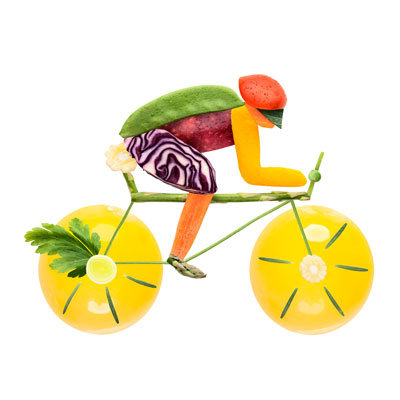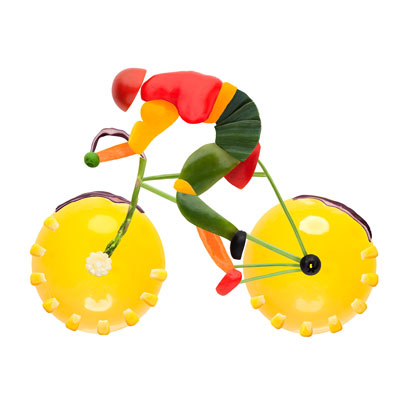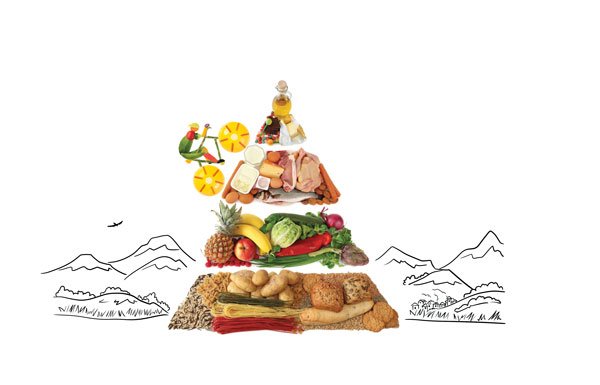A mindful approach to what you eat can help you reach your riding goals, explains Iain Treloar.
Many cyclists will have battled to shift the kilograms—a fact that applies to novice and elite riders alike. But there are likely different motivations at play here; the former camp may cycle to lose weight, while the latter may lose weight to cycle more competitively.
There are differences in the riding styles of these two groups, as well. At first, people new to riding are likely to be riding short distances, and, as such, will primarily be drawing on a combination of body fat and glycogen stores (stored carbohydrates mixed with water) for the energy expended.
Glycogen is readily accessible, but the body’s reserves are limited; enough to last about 90 minutes of sustained effort. As distances increase, the threshold at which glycogen is used will be passed, and the body will need to draw on other fuel. Even the leanest rider has enough body fat to last the longest possible ride, and at low to moderate intensities, fat is the body’s primary fuel source. However, most individuals aren’t able to metabolise it quickly enough for it to be an effective fuel when riding at higher intensities. And this is where carbohydrates come into the equation.
For rides of more than one hour that involve significant, high intensity efforts, a general rule is that you should aim to ingest around 30–60 grams of carbohydrate per hour, and 60–90 grams per hour if the total ride is greater than two hours. Carbs don’t just come from pasta and stodgy foods; many sports drinks contain them, as do gels and bars, so it’s possible to meet your carb-intake needs through conveniently packaged sports foods.
However, not all carbs are created equal. One way they’re categorised is a ranking along a glycaemic index (GI), which refers to the speed at which the body transforms carbohydrate into glucose, and hence fuel accessible to the body during exercise. High GI foods cause spikes in blood sugar—energy gels, for instance, are generally high GI to give you a quick boost. Low GI sports foods include sports bars, providing a more gradual release of energy. The two both serve a role, but they’re quite a different one. By using such sports products, or ‘real food’ alternatives of the sort developed by Dr Allen Lim in his excellent recipe book Feed Zone Portables (feedzonecookbook.com/portables), the body will be able to continue functioning at high intensities for much longer.
So that’s the basics of your mid-ride eating covered—but what of the broader dietary changes that can be made to get you in shape, and keep you there?
Which diet?
You won’t be shocked to discover that there are numerous and varied dietary approaches—high fat, low carb, the exact reverse and everything in between—each with their promoters and detractors.
 The current diet in vogue is low carb and high fat, generally known as the Banting diet. This has achieved some traction in the cycling community, and superficially, it’s easy to see the appeal—it rapidly drops weight (albeit largely as a result of fluid and glycogen loss rather than fat), and gives a green light to the fatty foods that cyclists might crave but see as ‘naughty’. But while this initial weight-loss is heartening, there is little yet to suggest this diet’s long-term efficacy. One trial comparing low carb and low fat diets, cited by Sports Dietitians Australia, showed that while a low carb diet resulted in a mean weight loss of 4.02kg over six months, that figure dropped to 1.05kg after a year and no appreciable difference between the two diets after three years. Furthermore, when you consider that the body’s primary energy source in high intensity exercise is glycogen stored from carbohydrate intake, the low carb diet can’t be said to be a magic bullet for the demands of a cycling lifestyle.
The current diet in vogue is low carb and high fat, generally known as the Banting diet. This has achieved some traction in the cycling community, and superficially, it’s easy to see the appeal—it rapidly drops weight (albeit largely as a result of fluid and glycogen loss rather than fat), and gives a green light to the fatty foods that cyclists might crave but see as ‘naughty’. But while this initial weight-loss is heartening, there is little yet to suggest this diet’s long-term efficacy. One trial comparing low carb and low fat diets, cited by Sports Dietitians Australia, showed that while a low carb diet resulted in a mean weight loss of 4.02kg over six months, that figure dropped to 1.05kg after a year and no appreciable difference between the two diets after three years. Furthermore, when you consider that the body’s primary energy source in high intensity exercise is glycogen stored from carbohydrate intake, the low carb diet can’t be said to be a magic bullet for the demands of a cycling lifestyle.
Accredited sports dietitian Alan McCubbin, of Next Level Nutrition (nextlevelnutrition.com.au), suggests a more inclusive approach. “A diet should be generally well balanced—it shouldn’t exclude complete groups of foods, such as dairy or vegetarian alternatives, grains or fruit. That’s not healthy for most people over the long term, physically or psychologically,” he says. Food doesn’t just provide us with the fuel to exercise; limiting or eliminating certain groups of food also reduces the potential for adequate intake of vitamins, minerals and fibre.
When presented with images of waifish riders like Chris Froome speeding up the mountains of the Tour de France, amateur riders may be inclined to try to emulate this physique. It’s fair to say that there’s a preoccupation with weight loss in road cycling; one of the most common guides by which serious riders measure their performance is power-to-weight ratio, which has taken over from heart rate as the primary metric for judging condition—one needs only look at the rapid expansion of the market for power meters as evidence of this.
But a regrettable side-effect of this preoccupation with weight is coaches recommending their riders to train hungry, from a belief that this will increase the rate of body fat loss. “I’ve yet to see any convincing evidence that this is the case, and chronically riding very long or very high intensity sessions in this way has probably contributed to many a health problem in elite level cyclists,” McCubbin says. “This can include viruses ranging from common colds through to glandular fever, and occasionally … can sadly lead to an athlete with an eating disorder.”
While I never quite got to that stage, from my days racing as a junior I can attest to the fact that skinfold measurements are not a normal, or particularly healthy, activity for a teenage boy to spend too much time worrying over. I may have been a skin-and-bones 55 kilograms, but with the benefit of hindsight, I certainly wasn’t getting faster the thinner I got. As my metabolism has slowed, I’ve put on weight, but I’ve added muscle and become a stronger rider, and that arguably wouldn’t have been the case if I hadn’t binned the skin-fold calipers and the unhealthy thought-patterns they engendered.
Conscious eating
Without taking any drastic steps such as cutting out entire categories of food from your diet (or stopping eating altogether), there are surprisingly simple ways to maintain a healthy weight—and the key here is moderation. Weight loss can very simply be summarised as kilojoules expended being greater than kilojoules consumed, and even without monitoring your portions with an eagle eye it may be possible to make some surprising losses.
 Having hibernated through winter, I jumped on the scales and found myself nudging 74kg, the heaviest I’d ever been—not overly promising for my next tilt at the Peaks Challenge in 2015. So, for the first time, I started watching what I was eating—realising that there’s no need for two big sandwiches at lunch, switching that occasional soft-drink for green tea and ditching the morning muffin. A recent two-week period of increased training and consciously eating less resulted in a loss of four kilograms, which wasn’t just a number on a scale—I was visibly leaner on both the legs and around the stomach. Obviously the rate at which individuals lose weight will vary significantly, but I was quite surprised at how easy it was to identify unnecessary snacks that could be eliminated—and lose a little excess baggage without any loss in perceived power on the bike, all without any greater dietary shift than a bit of mindful eating.
Having hibernated through winter, I jumped on the scales and found myself nudging 74kg, the heaviest I’d ever been—not overly promising for my next tilt at the Peaks Challenge in 2015. So, for the first time, I started watching what I was eating—realising that there’s no need for two big sandwiches at lunch, switching that occasional soft-drink for green tea and ditching the morning muffin. A recent two-week period of increased training and consciously eating less resulted in a loss of four kilograms, which wasn’t just a number on a scale—I was visibly leaner on both the legs and around the stomach. Obviously the rate at which individuals lose weight will vary significantly, but I was quite surprised at how easy it was to identify unnecessary snacks that could be eliminated—and lose a little excess baggage without any loss in perceived power on the bike, all without any greater dietary shift than a bit of mindful eating.
Now, there’s no ‘typical’ metabolism, and for others, those kilograms might prove a little more stubborn to shift—but it’s important to be sensible with your weight loss ambitions and ensure you’re still adequately nourished. A severely reduced dietary intake may have negative implications for performance on the bike; after all, if you’re well fuelled and a few kilos heavier you’re still better off than if you’re lighter and falling to pieces from calorific deficit mid-ride.
Multi-million dollar industries have sprung up on the promise of rapid weight loss, but the trick to maintaining athletic performance is a more gradual approach, not crash dieting. McCubbin cautions that abrupt dietary changes may have greater consequences than a loss of performance on the bike on a given day. “Rapid weight loss usually results in a loss of muscle (so loss of power on the bike), potentially a greater risk of illness, and a lowering of metabolic rate. This means it will be harder to maintain your lower weight after you’ve lost it.”
To the layperson, nutrition can be a complex science—and delving into the literature available can often feel like you’re being pulled in opposite directions. Adding to this complexity is the fact that outcomes can vary so much from one individual to the next, and the situations in which they’re exercising. Even fairly basic rules of thumb such as fat, glycogen and carbohydrate expenditure during exercise may vary; “some cyclists can exercise at fairly high intensities whilst still using primarily fat, whilst others are using more carbs than fat even at rest,” says McCubbin.
But if there’s one piece of advice that applies across the board, it’s avoiding sudden, potentially unhealthy changes. For most riders, the stick-thin physiques of elite athletes aren’t necessary, or healthy. Riding, at its core, is something that should be enjoyed, and a self-flagellating attitude to nutrition can strip some of that enjoyment away. But if you love riding your bike, then taking care of your body through a mindful approach to nutrition may help you enjoy riding more—and achieve riding goals previously out of reach.
For specific individual advice, you should consult a sports dietitian: sportsdietitians.com.au
Ride On content is editorially independent, but is supported financially by members of Bicycle Network. If you enjoy our articles and want to support the future publication of high-quality content, please consider helping out by becoming a member.


“A diet should be generally well balanced—it shouldn’t exclude complete groups of foods, such as dairy or vegetarian alternatives, grains or fruit. That’s not healthy for most people over the long term, physically or psychologically,” I am a cyclist a vegan (for over 20 years) and was trained in Dietetics but don’t practice it. Dietitians have got to stop thinking that without dairy products your health is somewhat compromised. Admittedly my knowledge of nutrition has enabled me to stay healthy over the years but good sound advice to the lay person should enable them to also stay healthy without dairy products (if they choose not eat them). Never a day goes by without some new research revealing the pros or cons of eating a particular food. Good nutrition is about a balanced diet from whichever food groups you choose to get your nutrients from. Part of your physchological health comes from being happy with who you are and that includes your choices in life. If you choose not to eat dairy for your own philosophical reasons this can only be good for your mental health. I encourage all Dietitians to think more broadly when it comes to a balanced diet.
Hi Lisa,
Intrigued by your response. I have been questioning my meat eating ways since starting to read “Eat To Run”. I am keen to start experimenting with veganism to see if I start to see any improvements in performance with my cycling and one day hopefully my running when i can return to that.